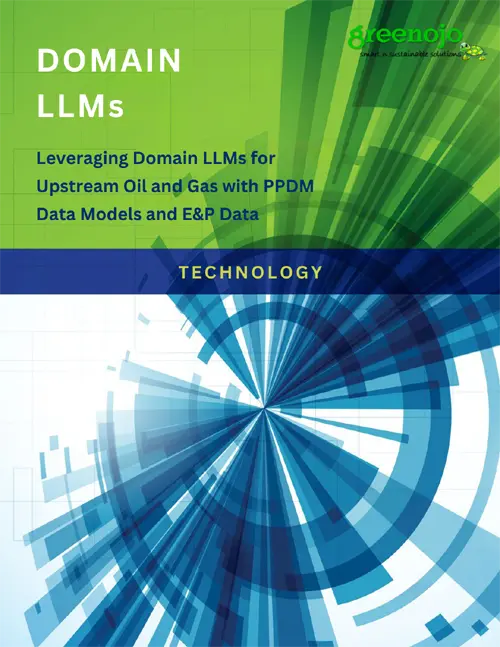The upstream oil and gas industry is navigating through an era where the integration of advanced technologies is becoming critical for operational excellence and sustainability. As the sector continues to generate vast amounts of data—from seismic surveys to drilling operations—the need for sophisticated tools to process, analyze, and derive actionable insights has never been more pressing. One of the most promising technological advancements in this field is the application of Domain-Specific Large Language Models (LLMs), specifically designed for upstream oil and gas operations, leveraging industry-standard PPDM (Professional Petroleum Data Management) data models and extensive Exploration & Production (E&P) datasets.
What Are Domain-Specific LLMs?
Large Language Models (LLMs) have transformed industries by enabling advanced natural language processing, data interpretation, and predictive analytics. When these models are fine-tuned for specific domains, such as upstream oil and gas, they become even more powerful. Domain-specific LLMs are tailored to understand and process the unique terminology, data structures, and operational nuances of the industry, making them indispensable tools for enhancing decision-making and optimizing operations.
In the upstream oil and gas sector, these LLMs are trained on a rich corpus of data that includes seismic data, well logs, production records, and more. By integrating PPDM data models—a globally recognized standard for managing petroleum data—these LLMs ensure that the data is organized, consistent, and ready for analysis across various stages of the E&P lifecycle.
The Role of PPDM Data Models

PPDM data models are foundational to effective data management in the oil and gas industry. They provide a standardized framework for structuring and managing data related to exploration, drilling, production, and other critical activities. The consistency and interoperability offered by PPDM models are crucial for integrating data across different systems and enabling seamless analysis and reporting.
When combined with domain-specific LLMs, PPDM data models facilitate:
Enhanced Data Quality: Ensuring that data is thoroughly cleaned, consistently accurate, and properly standardized, which is crucial for conducting effective and reliable analysis.
Data Integration: Enabling seamless integration of diverse data sources, enhancing the depth and comprehensiveness of the insights generated for more informed decision-making.
Regulatory Compliance: Supporting compliance with industry regulations by ensuring data management practices meet required standards.
Enhancing E&P Operations with Domain LLMs
The application of Domain LLMs in upstream oil and gas is transforming how companies handle Exploration and Production (E&P) data. These models offer several key advantages:
Advanced Data Interpretation: Domain LLMs can process vast amounts of unstructured data, such as drilling logs and seismic reports, providing insights that would be difficult to obtain through traditional methods. This capability is particularly valuable in identifying patterns and anomalies that could impact exploration success or operational efficiency.
Predictive Analytics: By analyzing historical data, Domain LLMs can predict future trends and operational outcomes, such as drilling success rates or potential equipment failures. This predictive capability is invaluable for proactive decision-making, reducing risks, and optimizing resource allocation.
Enhanced Communication: LLMs trained on industry-specific language and terminology enable more accurate and effective communication among teams, from geologists to engineers, ensuring that all stakeholders are on the same page.
“Domain-Specific LLMs, when combined with PPDM data models, are revolutionizing upstream oil and gas operations by enhancing data quality, enabling predictive analytics, and driving smarter, more sustainable decisions.”
Practical Applications in Upstream Oil and Gas
The potential applications of Domain LLMs in the upstream sector are extensive:
Seismic Data Analysis: LLMs can enhance the interpretation of seismic data by identifying subtle patterns and correlations that may not be evident through traditional analysis methods. This can lead to more accurate subsurface models and better-informed exploration decisions.
Drilling Optimization: By analyzing data from past drilling operations, Domain LLMs can optimize drilling parameters in real-time, improving efficiency and reducing the likelihood of costly errors.
Production Forecasting: Domain LLMs can analyze production data to forecast future output, helping companies plan their operations and investments more effectively.
The Future of Domain LLMs in Oil and Gas
As the upstream oil and gas industry continues to evolve, the role of Domain LLMs will become increasingly important. These models offer the potential to revolutionize how companies manage their data, make decisions, and operate day-to-day. By leveraging PPDM data models and E&P datasets, Domain LLMs provide a powerful toolset for improving efficiency, reducing costs, and driving innovation in the upstream sector.
In conclusion, the integration of Domain LLMs with PPDM data models represents a significant advancement for the upstream oil and gas industry. These technologies not only enhance the quality and integration of data but also enable advanced analytics that can drive smarter, more sustainable operations. As the industry continues to embrace digital transformation, Domain LLMs will undoubtedly play a crucial role in shaping its future.




